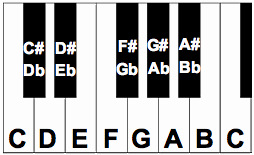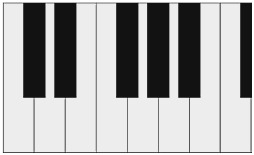Analyzing a piano keyboard diagram can make almost anyone run in fear. Don’t let the beast scare you away.
It’s really not that bad. Trust Me!
There are so many notes to learn it can seem almost impossible to completely understand it all.
Not for You!
The piano keyboard is really not all that difficult. There is an easy to follow pattern throughout the entire piano that makes it easy to learn every note fast.
We are going to take an in depth look at the piano keyboard and find an easy way to make sense of it all.
I have included an easy to use piano key chart that will help you practice and master the notes on the piano.
Labeled Diagram
There are two types of piano keyboard diagrams; labeled chart and unlabeled chart. Each of these has their own specific use.
The labeled piano diagram is helpful for the beginner piano player.
When you are first learning piano notes you can use this piano note diagram to help you easily find any note on the piano.
Each note on the keyboard is labeled giving you a complete visual guide of all the notes. This is very helpful for the beginner, but it can cause some lag in the learning process.
Beginners tend to “over-use” these types of recourses. They feel as though they need to rely on the piano keyboard diagram rather then only using it when its necessary. It’s important to know when to put it aside when as start feeling more comfortable with the piano.

Blank Piano Note Diagram
The unlabeled piano keyboard diagram is very useful for the piano instructor, or when quizzing yourself once you become more familiar with the notes on the piano keyboard.
It is also very helpful if you don’t have a piano close by.
This diagram is a complete blank slate of the piano.
Having no note names on it whatsoever is helpful because it can allow you to quiz yourself.
Remember in school when your teacher made you copy everything off of there board? Writing things down is a form of learning that helps reinforce a concept.
You can use the piano keyboard diagram to help reinforce and review the notes on the piano keyboard by writing the notes on a blank diagram.
This exercise is great for kids! It can also be very helpful for adults.

Piano Keyboard Diagram
Below you will find all of the piano note diagrams available. Each of them can be used in a unique way to help you better read the notes on the piano. Use the ideas above along with any other ideas you may come up with to help you better understand the layout of piano keys.
Included are diagrams starting with one octave, all the way up to four octaves.
When starting out I would recommend using the one octave diagram. This will help you learn the notes A through G much easier. It will focus only on those notes rather than on the entire piano keyboard.
Focus on learning one octave. When you have that perfected you can then move on to a larger chart.
Once you are more comfortable with the one octave you can then move on to more octaves. This way you are not overwhelmed at first and you can focus on learning the notes without getting lost.
Click Here To download the Labeled Piano Diagram
Click Here To Download The Unlabeled Piano Diagram
Here is the list that contains every piano keyboard diagram.
I hope they are helpful. If you can think of more creative ways to use these charts, contact me and let me know.
Labeled
1 Octave

2 Octave

3 Octave

4 Octave

Unlabeled
1 Octave

2 Octave

3 Octave

4 Octave

Dissecting The Piano
The keys on the piano are organized in a pattern that repeats itself throughout the piano keyboard.
The first thing that you notice is the white and black keys. The white keys represent natural notes and the black keys represent sharps and flats.
To easily understand the order of the piano keys you must first find the sets of black keys.
There is a set of two black keys, and a set of three black keys. Once you locate the set of two black keys you can easily find a C note. Locate the white key to the left of the set of two black keys, this is C note.
Notes on the Piano
Now that you can easily find C, you can now name any white note on the piano.
Using the piano keyboard diagram you can now label the rest of the white notes by counting up the alphabet. This means that the white note next to C is D, the note next to D is E, and so on.
Continue up the alphabet until you reach G. Once at G you start back over at A.
See the pattern?
As soon as you reach A, you have now started the pattern that will continue throughout the entire piano keyboard.
Go From Piano Keyboard Diagram Back to Piano Theory
Back to Home Page

